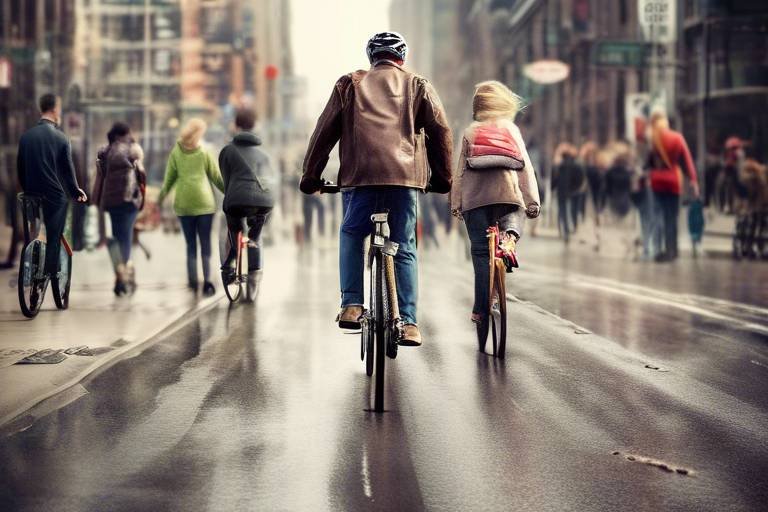The Benefits of Using a Bicycle for Commuting
In today's fast-paced world, commuting has become a significant part of our daily lives. But have you ever considered how a simple shift in your mode of transport could transform your experience? Cycling is not just a means to get from point A to point B; it’s an adventure that brings a plethora of benefits to your health, the environment, and even your wallet. Imagine gliding through the streets, the wind in your hair, and the thrill of being part of a vibrant community of cyclists. In this article, we will explore the numerous advantages of cycling as a mode of transport for daily commutes, including health, environmental, and economic benefits that can enhance your overall quality of life.
Cycling regularly can significantly improve your physical health. It’s like a magic pill for your body that enhances cardiovascular fitness, boosts muscle strength, and promotes mental well-being. Just think about it: every time you hop on your bike, you’re not just commuting; you’re engaging in a workout that can help reduce the risk of chronic diseases such as obesity, diabetes, and heart disease. Plus, cycling can be a fantastic stress reliever. After a long day, a bike ride can clear your mind, making you feel rejuvenated and ready to tackle whatever life throws your way. So, why not trade your car seat for a bike saddle? Your body will thank you!
Choosing to cycle instead of driving is like giving Mother Earth a big hug. Bicycles are eco-friendly machines that reduce carbon emissions, decrease air pollution, and contribute to a more sustainable environment. By cycling, you’re not just improving your health; you’re also making a responsible choice for our planet. In fact, did you know that for every mile cycled, you can save about 1 pound of carbon dioxide from being emitted into the atmosphere? That’s a powerful statistic!
Another remarkable benefit of cycling is its ability to alleviate traffic congestion. Bicycles take up significantly less space on the road compared to cars. Imagine a world where fewer cars mean smoother commutes for everyone. When more people choose to cycle, we can say goodbye to gridlock and hello to a more efficient transportation system. Less time stuck in traffic means more time for the things you love!
To encourage more people to cycle, cities must invest in bicycle-friendly infrastructure. This includes bike lanes, secure parking facilities, and well-designed routes that make cycling safe and enjoyable. When communities prioritize cycling, they promote a culture of health and sustainability. It’s a win-win situation that not only benefits cyclists but also enhances the quality of life for all residents.
Cycling fosters community interactions and social connections. Ever noticed how cyclists often wave at each other? It creates a sense of belonging! Group rides, local cycling events, and community challenges enhance community spirit and engagement. When you cycle, you’re not just commuting; you’re becoming part of a larger movement that values health, sustainability, and camaraderie.
Let’s talk about the money, shall we? Cycling can lead to significant savings on fuel, parking, and vehicle maintenance costs. Think about all the expenses that come with owning a car. Now, imagine slashing those costs by simply riding a bike. Not only will you save money, but you’ll also enjoy the freedom of not being tied down by car payments, insurance, and repairs. Cycling is not just good for your health and the environment; it’s also a financially savvy choice for daily commuters.
While cycling offers numerous benefits, it’s crucial to understand the importance of safety measures. Ensuring a safe commuting experience helps reduce accidents and injuries, making the roads safer for everyone. So, what can you do to stay safe while cycling? Let’s dive into some essential safety tips.
First and foremost, wearing a helmet is non-negotiable. It’s your best defense against head injuries in case of an accident. Additionally, using reflective gear can greatly enhance your visibility, especially during low-light conditions. Think of it as your superhero outfit that keeps you safe while you conquer the roads!
Familiarizing yourself with traffic laws and proper cycling etiquette is equally important. Understanding the rules of the road ensures safer interactions with vehicles and pedestrians, promoting a harmonious coexistence. Remember, being a responsible cyclist not only protects you but also contributes to a safer community for everyone.
- Is cycling safe for commuting? Yes, cycling can be safe if you follow traffic laws, wear a helmet, and use proper safety gear.
- What are the best types of bicycles for commuting? Hybrid bikes, road bikes, and electric bikes are popular choices for commuting, depending on your needs.
- How can I stay motivated to cycle regularly? Setting goals, joining local cycling groups, and tracking your progress can help keep you motivated.
- What should I wear while cycling? Wear comfortable clothing, a helmet, and reflective gear for visibility, especially at night.

Health Benefits of Cycling
This article explores the numerous advantages of cycling as a mode of transport for daily commutes, including health, environmental, and economic benefits that can enhance your overall quality of life.
Cycling regularly can significantly improve your physical health in ways that you might not even realize. Imagine pedaling your way to better cardiovascular fitness, enhanced muscle strength, and improved mental well-being—all while enjoying the fresh air and the sights of your neighborhood. It's like hitting multiple birds with one stone! When you cycle, you're not just commuting; you're actively engaging in a form of exercise that can help reduce the risk of chronic diseases such as heart disease, diabetes, and obesity.
Moreover, cycling is a low-impact exercise, making it easier on your joints compared to running or other high-impact activities. This means you can enjoy the benefits without the wear and tear that comes with more strenuous workouts. Think of it as a gentle nudge to your body, encouraging it to stay fit without pushing it to the limit. A study published in the Journal of Physical Activity and Health found that individuals who cycle regularly have a lower risk of cardiovascular disease compared to non-cyclists. Isn't that a compelling reason to hop on a bike?
But the benefits don't stop there! Cycling has also been linked to improved mental health. Picture this: the wind in your hair, the sun on your face, and the rhythmic motion of pedaling can elevate your mood and reduce stress. It's like a mini-vacation every day! Research suggests that regular cyclists report lower levels of anxiety and depression. The combination of physical activity and being outdoors can work wonders for your mental clarity and emotional resilience.
Additionally, cycling can be a fantastic social activity. Whether you're joining a cycling group or simply riding with friends, it fosters connections and creates opportunities for social interaction. This sense of community can further enhance your mental well-being, making you feel more connected and engaged.
In summary, the health benefits of cycling are manifold:
- Improved cardiovascular fitness
- Increased muscle strength
- Lower risk of chronic diseases
- Enhanced mental well-being
- Social interaction opportunities
So, if you're looking for a way to boost your health while commuting, cycling might just be the answer. It's not just about getting from point A to point B; it's about transforming your commute into a holistic health experience. Why not give it a try? Your body and mind will thank you!
Choosing to cycle instead of driving reduces carbon emissions, decreases air pollution, and contributes to a more sustainable environment, making it a responsible choice for eco-conscious commuters.
Bicycles take up less space on the road, helping to alleviate traffic congestion, leading to smoother commutes for all road users and less time spent in gridlock.
Investing in bike lanes and parking facilities encourages more people to cycle, promoting a culture of cycling and further reducing reliance on cars in urban areas.
Cycling fosters community interactions and social connections, as it creates opportunities for group rides and local events, enhancing community spirit and engagement.
Cycling can lead to significant savings on fuel, parking, and vehicle maintenance costs, making it a financially savvy choice for daily commuters.
Understanding the importance of safety measures while cycling can help reduce accidents and injuries, ensuring a safer commuting experience for all cyclists.
Wearing a helmet and using reflective gear can greatly enhance visibility and protection, helping cyclists stay safe on the road, especially in low-light conditions.
Familiarizing oneself with traffic laws and proper cycling etiquette can contribute to safer interactions with vehicles and pedestrians, promoting a harmonious coexistence on the roads.
1. Is cycling safe for daily commuting?
Cycling can be safe if proper safety measures are taken, such as wearing a helmet and following traffic laws.
2. How does cycling benefit mental health?
Cycling releases endorphins, which can help reduce stress and anxiety levels, improving overall mental well-being.
3. Can cycling help with weight loss?
Yes! Regular cycling can be an effective way to burn calories and contribute to weight loss when combined with a balanced diet.
4. What equipment do I need to start cycling?
At a minimum, you will need a bicycle, a helmet, and possibly reflective gear for safety, especially when cycling at night.
5. How can I stay motivated to cycle regularly?
Setting goals, joining cycling groups, or even tracking your progress can help keep you motivated and engaged in cycling as a commuting option.

Environmental Impact
Choosing to cycle instead of driving is more than just a personal choice; it's a powerful statement about your commitment to the planet. When you hop on a bicycle, you are actively participating in the fight against climate change. Did you know that the transportation sector is one of the largest contributors to greenhouse gas emissions? By cycling, you can significantly reduce your carbon footprint and contribute to a healthier environment. Imagine the impact if everyone opted for two wheels instead of four!
One of the most immediate benefits of cycling is the reduction in carbon emissions. Cars release a significant amount of carbon dioxide and other harmful pollutants into the atmosphere. In contrast, bicycles are a zero-emission mode of transport. According to studies, replacing just one car trip per day with a bike ride can save approximately 1,000 pounds of carbon dioxide each year. That’s like planting a small tree every year!
Moreover, cycling helps to decrease air pollution. Cities around the globe are grappling with poor air quality due to vehicle emissions. By cycling, you are not only improving your own health but also contributing to cleaner air for your community. This is especially crucial in urban areas where smog and pollution can lead to serious health problems, such as respiratory diseases. Think of cycling as a breath of fresh air—literally!
Another significant environmental benefit is the reduction of traffic congestion. Bicycles take up much less space on the road compared to cars. Fewer cars mean less traffic, which translates to smoother commutes for everyone. This not only saves time but also reduces the overall fuel consumption of the remaining vehicles on the road. Consider this: for every 1% increase in cycling, there is a corresponding 0.5% decrease in traffic congestion. It’s a win-win situation!
To further enhance these environmental benefits, cities need to invest in bicycle-friendly infrastructure. This includes dedicated bike lanes, bike-sharing programs, and secure parking facilities. When cities prioritize cycling, it encourages more people to make the switch from cars to bikes. Imagine a city where bike lanes are as common as car lanes, making cycling not just an option, but the preferred mode of transport!
By fostering a culture of cycling, we can create a more sustainable urban environment. Not only does this reduce reliance on cars, but it also promotes a healthier lifestyle among residents. In fact, cities that have invested in bike infrastructure have reported a 20% increase in cycling rates within just a few years. This shift not only benefits the environment but also enhances the overall quality of life for the community.
Cycling also has a unique way of fostering community engagement. When people cycle together, they create bonds and connections that are often absent in car culture. Group rides, local cycling events, and community bike workshops can bring people together, enhancing community spirit. It’s not just about getting from point A to point B; it’s about building relationships and creating a sense of belonging. Picture a vibrant community where neighbors greet each other on their bikes, sharing smiles and stories as they ride through the streets!
In conclusion, the environmental impact of cycling is profound. From reducing carbon emissions and air pollution to alleviating traffic congestion and fostering community engagement, cycling is a sustainable choice that benefits us all. So why not take that leap and embrace the joy of cycling? Your body, your wallet, and our planet will thank you!
- How does cycling help the environment? Cycling reduces carbon emissions, decreases air pollution, and alleviates traffic congestion.
- What are the health benefits of cycling? Cycling improves cardiovascular fitness, builds muscle strength, and enhances mental well-being.
- Is cycling safe? Yes, by following traffic laws and wearing proper safety gear, cycling can be a safe mode of transport.
- How can communities encourage cycling? By investing in bicycle-friendly infrastructure and organizing local cycling events.

Reduction of Traffic Congestion
Imagine a world where your daily commute isn't a battle against honking horns and endless stoplights. Instead, picture gliding smoothly past the gridlock on your bicycle, with the wind in your hair and a smile on your face. Cycling has the unique ability to significantly reduce traffic congestion, transforming the way we navigate our urban landscapes. When more individuals opt for bicycles over cars, the number of vehicles on the road decreases, leading to a more fluid traffic flow. This not only benefits cyclists but also enhances the commuting experience for everyone, including those who still rely on cars.
One of the most striking aspects of cycling is its efficiency in space usage. A single bicycle occupies far less road space than a car, allowing for a more efficient use of our streets. In fact, studies have shown that one bicycle can replace 10 cars on the road. This means that as more people choose to cycle, we can see a notable decline in traffic jams, making the roads safer and more navigable for all. It’s akin to removing the clutter from a crowded room—suddenly, there’s more room to breathe and move around.
Furthermore, the reduction in traffic congestion leads to decreased travel times. Cyclists can often bypass bottlenecks and take shortcuts that cars simply can’t access. This not only saves time but also reduces stress levels associated with commuting. Think about it: when was the last time you felt calm and collected stuck in traffic? With cycling, you can reclaim that time and use it to enjoy your morning coffee or catch up on a podcast.
To illustrate the impact of cycling on traffic congestion, consider the following table that compares the space occupied by different modes of transport:
| Mode of Transport | Average Space Occupied (in feet) | Number of Passengers | Space per Passenger (in feet) |
|---|---|---|---|
| Bicycle | 6 | 1 | 6 |
| Car | 20 | 1.5 | 13.3 |
| Bus | 40 | 30 | 1.3 |
This table clearly shows how bicycles utilize space more efficiently than cars, making them a key component in alleviating traffic congestion. As cities invest in cycling infrastructure, such as dedicated bike lanes and secure parking areas, we can expect to see even more people opting for bikes, further reducing the number of vehicles on the roads.
In conclusion, the reduction of traffic congestion through cycling is not just a dream; it’s a tangible reality that can be achieved with collective effort. By choosing to ride a bicycle, we can all contribute to a smoother, safer, and more enjoyable commuting experience. So why not join the movement? Your city—and your fellow commuters—will thank you!
- How does cycling help reduce traffic congestion?
Cycling takes up less road space than cars, allowing more people to travel efficiently and reducing the overall number of vehicles on the road. - Is it safe to cycle in busy urban areas?
Yes, with proper safety gear and adherence to traffic laws, cycling can be safe. Many cities are investing in bike lanes to enhance cyclist safety. - What are the health benefits of cycling?
Cycling improves cardiovascular fitness, builds muscle strength, and enhances mental well-being, among other health benefits.

Creating Bicycle-Friendly Infrastructure
When it comes to encouraging more people to hop on their bikes instead of jumping in their cars, is absolutely essential. Imagine a world where bike lanes are as common as sidewalks, where cyclists can glide through the city without fear of being squeezed off the road. This vision is not just a dream; it’s a necessity for modern urban living. By investing in dedicated bike lanes, secure parking facilities, and well-designed intersections, cities can transform the commuting landscape for the better.
Think about it: when a city prioritizes cycling, it sends a powerful message that biking is a legitimate mode of transport. This not only encourages more individuals to consider cycling as a viable option but also contributes to a culture where everyone respects cyclists. For instance, cities like Amsterdam and Copenhagen have set the gold standard with their extensive cycling infrastructure, showcasing how it can be done. In these cities, the roads are designed to accommodate cyclists, with clear lanes that are separated from vehicle traffic, making it safer and more enjoyable to ride.
Moreover, the benefits extend beyond just the cyclists. With fewer cars on the road, traffic congestion decreases, leading to smoother commutes for all. This reduction in congestion can significantly decrease travel time, allowing everyone to get to their destinations faster. A well-planned cycling infrastructure can also enhance the aesthetic appeal of a city, with tree-lined bike paths and vibrant community spaces that make urban areas more livable and attractive.
To further illustrate the impact of bicycle-friendly infrastructure, consider the following table that highlights the key components and their benefits:
| Infrastructure Component | Benefits |
|---|---|
| Dedicated Bike Lanes | Increases safety, encourages more riders, reduces vehicle congestion |
| Bicycle Parking Facilities | Provides secure storage, reduces theft, promotes cycling as a daily option |
| Traffic Calming Measures | Slows down vehicle traffic, enhances safety for cyclists and pedestrians |
| Public Awareness Campaigns | Educates the public on cycling benefits, promotes respect between cyclists and drivers |
Investing in these components not only enhances the cycling experience but also contributes to a healthier, more sustainable environment. Cities that embrace cycling as a core aspect of their transportation strategy often see a ripple effect, where public health improves, air quality enhances, and community connections deepen. So, the next time you think about commuting, consider how your city can make cycling easier and more appealing for everyone. After all, a bike-friendly city is a happy city!
1. What are the main benefits of having bike lanes?
Bike lanes increase safety for cyclists, reduce traffic congestion, and encourage more people to consider cycling as a viable transportation option.
2. How can communities promote cycling?
Communities can promote cycling by investing in infrastructure, hosting cycling events, and creating public awareness campaigns about the benefits of cycling.
3. Are there any economic benefits to cycling infrastructure?
Yes! Bicycle-friendly infrastructure can lead to reduced transportation costs for individuals, lower healthcare costs due to increased physical activity, and increased business for local shops as more people bike to their destinations.
4. What safety measures should cyclists take?
Cyclists should always wear helmets, use reflective gear, and follow traffic laws to ensure their safety while riding.

Community Engagement
Cycling is more than just a mode of transport; it's a gateway to and social interaction. When you hop on your bike, you’re not just riding through your neighborhood; you’re becoming part of a vibrant tapestry of local life. Picture this: as you pedal down the street, you might pass by a neighbor walking their dog, wave to someone washing their car, or even stop to chat with a fellow cyclist. These small interactions create a sense of belonging and connection that is often missing in our fast-paced, car-centric lives.
Moreover, bicycles serve as a catalyst for community events and group activities. Think about local charity rides, cycling clubs, or weekend meet-ups. These gatherings not only promote fitness but also foster friendships and camaraderie among participants. When people come together for a common passion—like cycling—they share stories, experiences, and laughter, strengthening community ties. In essence, cycling can transform strangers into friends, making our neighborhoods feel more like home.
To further illustrate the impact of cycling on community engagement, consider the following benefits:
- Increased Local Events: More bike riders often lead to more organized events, such as fun rides, races, and festivals that celebrate cycling culture.
- Support for Local Businesses: Cyclists are more likely to stop at local shops and cafes, boosting the economy and promoting small businesses.
- Improved Public Spaces: As cycling becomes more popular, communities often invest in better roads, bike lanes, and parks, enhancing the quality of life for everyone.
Additionally, cycling encourages a more active lifestyle, which can lead to a healthier community overall. When people cycle, they are more likely to engage in other physical activities, creating a culture of health and wellness. This collective shift towards a more active lifestyle can have profound effects on public health, reducing healthcare costs and improving the quality of life for residents.
In conclusion, cycling is not just about getting from point A to point B; it’s about building connections, fostering community spirit, and enhancing the overall quality of life. So, the next time you consider cycling to work or for leisure, remember that you’re also contributing to a larger community. Embrace the journey, and enjoy the ride!
- What are the best ways to get involved in community cycling events?
Check local community boards, social media groups, or cycling clubs in your area. Many cities have organized rides and events throughout the year.
- How can I promote cycling in my community?
Start by organizing group rides, advocating for bike lanes, or even hosting workshops to teach others about bike maintenance and safety.
- Are there any risks associated with cycling in a community?
As with any activity, there are risks, but wearing safety gear, obeying traffic laws, and being aware of your surroundings can significantly reduce them.

Economic Savings
When you think about commuting, the first thing that often comes to mind is the **cost**. Let's face it, commuting can be a financial burden. But what if I told you that swapping your car for a bicycle could not only lighten your environmental footprint but also save you some serious cash? Imagine the sound of your wallet sighing in relief! Cycling isn’t just a healthy choice; it’s also an incredibly **economical** one.
First off, consider the **fuel costs**. With the price of gasoline fluctuating like a rollercoaster ride, it’s no wonder many people feel like they’re throwing money down the drain every time they fill up their tank. By cycling, you eliminate fuel expenses altogether. Instead of spending a chunk of your paycheck on gas, you can invest in a good quality bike and some essential gear. In fact, here’s a simple breakdown:
| Expense Type | Car Commuting (Annual Cost) | Bicycle Commuting (Annual Cost) |
|---|---|---|
| Fuel | $1,200 | $0 |
| Insurance | $1,000 | $0 |
| Maintenance | $500 | $100 |
| Parking | $600 | $0 |
| Total Annual Cost | $3,400 | $100 |
As you can see, the **savings** are staggering! You’re not just saving a few bucks here and there; you could potentially save **thousands of dollars** each year just by choosing to ride a bike. And let’s not forget about the hidden costs of owning a car, like **depreciation** and unexpected repairs. These can add up quickly, while a bicycle requires minimal maintenance and can last for years with proper care.
Moreover, consider the cost of parking. In urban areas, parking fees can be a real headache. By cycling, you can say goodbye to those annoying parking meters and the frustration of finding a spot. Instead, you can simply lock your bike at a designated rack and be on your way. It’s like having a VIP pass to the city!
Now, let’s talk about the **health benefits** of cycling, which also contribute to economic savings in a roundabout way. By incorporating cycling into your daily routine, you’re likely to improve your health, which means fewer medical bills in the long run. You’re investing in your well-being, which is an invaluable asset. Think of it as a **preventive measure** that pays off later.
In summary, cycling is not just a mode of transport; it’s a **financial strategy**. The economic benefits are clear: from reduced fuel and maintenance costs to savings on parking and health expenses, cycling can help you keep more money in your pocket. So, why not make the switch? You’ll not only feel great but also see the savings roll in!
- How much can I save annually by cycling instead of driving?
The average commuter can save over $3,000 a year by cycling instead of driving, considering fuel, maintenance, insurance, and parking costs.
- Is cycling safe for commuting?
Yes, cycling can be safe if you follow traffic laws, wear a helmet, and use reflective gear. Familiarizing yourself with cycling etiquette also enhances safety.
- What type of bike should I buy for commuting?
Choosing the right bike depends on your commuting distance and terrain. Road bikes are great for long distances on paved roads, while hybrid bikes offer versatility for various surfaces.

Safety Considerations
When it comes to cycling, safety should never be an afterthought; it should be a top priority. Imagine riding your bike through a bustling city, the wind in your hair, the sun shining down, and yet, lurking around every corner are potential hazards. To fully enjoy the freedom and benefits of cycling, it’s essential to adopt safety measures that protect you from accidents and injuries. Understanding these precautions can transform your cycling experience from a daunting task into a delightful adventure.
One of the most crucial aspects of cycling safety is wearing a helmet. A helmet acts as your first line of defense against head injuries in the event of a fall or collision. According to studies, wearing a helmet can reduce the risk of head injuries by up to 85%. So, think of your helmet as an insurance policy—an investment in your well-being. But don’t stop there; consider using additional safety gear like reflective clothing and lights. These items significantly enhance your visibility, especially during early morning or late evening rides when the light is low. The more visible you are, the safer you will be on the road.
Moreover, it’s vital to familiarize yourself with traffic laws and proper cycling etiquette. Just like drivers, cyclists must adhere to the rules of the road. This includes signaling your turns, stopping at red lights, and riding in the same direction as traffic. By following these laws, you not only protect yourself but also contribute to a safer environment for everyone. It’s also wise to be aware of your surroundings—always keep an eye on parked cars, as doors can swing open unexpectedly, and watch out for pedestrians who may not see you coming.
To further enhance your safety, consider the following tips:
- Always ride with both hands on the handlebars unless signaling.
- Keep a safe distance from vehicles, especially large trucks or buses.
- Use bike lanes whenever possible; they are specifically designed to keep cyclists safe.
- Be cautious at intersections, as they are common spots for accidents.
Lastly, remember that cycling can also be a social activity. Engaging in group rides can provide an extra layer of safety, as there’s strength in numbers. Plus, it’s a great way to meet fellow cycling enthusiasts and share tips on how to stay safe on your bike. So, whether you're commuting to work or enjoying a leisurely ride, always prioritize safety—it’s the key to a fulfilling cycling experience.
Q: What should I do if I get into an accident while cycling?
A: First, check for injuries and seek medical attention if necessary. If possible, document the scene, collect witness information, and contact the authorities.
Q: Is it necessary to wear a helmet while cycling?
A: While laws vary by location, wearing a helmet is highly recommended as it significantly reduces the risk of serious head injuries.
Q: How can I improve my cycling skills for safety?
A: Consider taking a cycling safety course, practice riding in different conditions, and always stay aware of your surroundings.
Q: What should I do if a car is too close to me while cycling?
A: If a car is too close, try to maintain your course and avoid sudden movements. If you feel threatened, find a safe place to pull over until the vehicle passes.

Helmet and Gear Importance
When it comes to cycling, one of the most crucial aspects that cannot be overlooked is the importance of wearing a helmet and using appropriate gear. Imagine riding your bike down a beautiful tree-lined street, the wind in your hair, and the sun shining down. It feels exhilarating, right? But what if, in the blink of an eye, something unexpected happens? A helmet is your first line of defense against potential head injuries. It's not just a piece of equipment; it’s a lifesaver. In fact, studies have shown that wearing a helmet can reduce the risk of head injury by up to 85%. That's a statistic that should make anyone think twice before hopping on a bike without one!
But helmets are just the beginning. Other gear plays a significant role in ensuring your safety while cycling. For instance, reflective clothing can increase your visibility, especially during low-light conditions. Think of it this way: when you're out on the road, you're like a bright star in a dark sky. The more you shine, the easier it is for drivers and other cyclists to see you. This is particularly important during dawn or dusk, where visibility can be compromised. Investing in high-visibility gear is a small price to pay for peace of mind.
Furthermore, wearing padded shorts can make your rides more comfortable. Nobody wants to feel sore after a long commute! These shorts are designed to reduce friction and provide cushioning, making your journey much more enjoyable. And let’s not forget about gloves! They not only provide a better grip on the handlebars but also protect your hands in case of a fall. Each piece of gear serves a unique purpose, and together, they create a comprehensive safety net for cyclists.
To illustrate the importance of cycling gear, consider the following table that outlines essential items and their benefits:
| Gear Item | Benefits |
|---|---|
| Helmet | Protects against head injuries; reduces risk of serious trauma. |
| Reflective Clothing | Enhances visibility; increases safety during low-light conditions. |
| Padded Shorts | Increases comfort; reduces friction during long rides. |
| Gloves | Improves grip; protects hands in case of a fall. |
In conclusion, prioritizing safety gear while cycling is not just a recommendation; it's a necessity. Every time you ride, you are taking a step towards a healthier lifestyle, but you should also be taking steps to protect yourself. So, the next time you grab your bike, make sure to put on your helmet and gear. After all, safety is the best accessory you can wear!
- What type of helmet should I buy? Look for a helmet that meets safety standards and fits comfortably. Make sure it’s snug but not too tight.
- Is it really necessary to wear a helmet? Yes! Wearing a helmet significantly reduces the risk of serious head injuries during accidents.
- What other gear is essential for safe cycling? Apart from a helmet, consider wearing reflective clothing, padded shorts, and gloves for added protection and comfort.
- How often should I replace my helmet? It's recommended to replace your helmet every 3-5 years or immediately after an impact.

Traffic Laws and Cycling Etiquette
When it comes to cycling, understanding traffic laws and practicing good cycling etiquette is essential for ensuring the safety of both cyclists and motorists. Just like any other vehicle on the road, bicycles are subject to the same rules and regulations that govern traffic. This means that cyclists must adhere to traffic signals, stop at red lights, and yield to pedestrians at crosswalks. But what does this really mean for you as a cyclist? Well, it’s about being responsible and respectful on the road, which can ultimately create a safer environment for everyone.
One of the first things to keep in mind is that cyclists should ride in the same direction as traffic. This not only helps you be more visible to drivers but also allows you to anticipate potential hazards. Additionally, it’s crucial to use hand signals when turning or stopping. Not only does this communicate your intentions to drivers, but it also fosters a sense of trust and cooperation on the road. For instance, extending your left arm straight out indicates a left turn, while bending your left arm at a 90-degree angle signals a right turn. Simple, right? But it can make a huge difference.
Moreover, being aware of your surroundings is key. This means keeping an eye out for parked cars, pedestrians, and other cyclists. You never know when a car door might swing open unexpectedly or when a child might dart into the street. By staying alert, you can react quickly and avoid accidents. It’s also a good idea to maintain a safe distance from vehicles, especially large trucks or buses, which can create wind gusts that may destabilize your ride.
In addition to traffic laws, practicing good cycling etiquette can enhance the overall experience for everyone on the road. Here are a few points to consider:
- Be Predictable: Always ride in a straight line and avoid sudden movements. This makes it easier for drivers to anticipate your actions.
- Respect Others: If you’re riding in a group, communicate with each other and maintain a single file line when necessary.
- Stay Off Sidewalks: In most places, riding on sidewalks is illegal and can pose a danger to pedestrians.
Finally, it’s important to familiarize yourself with local cycling laws, as they can vary from one city or state to another. Some places may have specific regulations regarding the use of bike lanes, while others may have laws about riding at night. Knowing these rules not only keeps you safe but also helps you avoid fines. Remember, being a responsible cyclist is not just about following the law; it’s about contributing to a positive cycling culture that encourages more people to take up biking as a viable mode of transportation.
Q: Do I need to wear a helmet while cycling?
A: While helmet laws vary by location, wearing a helmet is highly recommended for your safety, regardless of the law.
Q: Can I ride my bike on the sidewalk?
A: This depends on local laws. In many places, riding on sidewalks is prohibited, especially in urban areas. Always check your local regulations.
Q: What should I do if I encounter aggressive drivers?
A: Stay calm and avoid confrontation. If a driver is behaving aggressively, it’s best to keep your distance and focus on your safety.
Frequently Asked Questions
- What are the health benefits of cycling to work?
Cycling to work can significantly boost your physical health. It enhances cardiovascular fitness, strengthens muscles, and improves mental well-being. Regular cycling also helps in reducing the risk of chronic diseases such as diabetes and heart disease. It's like getting a workout while commuting—how cool is that?
- How does cycling help the environment?
Choosing to cycle instead of driving reduces carbon emissions and air pollution. It’s a fantastic way to contribute to a more sustainable environment. Think of it as giving Mother Earth a big hug while you pedal along!
- Can cycling really reduce traffic congestion?
Absolutely! Bicycles take up much less space on the road compared to cars. By cycling, you not only ease your own commute but also help reduce gridlock for everyone else. It's like being part of a team that works together to make the roads smoother for all!
- What is the importance of bicycle-friendly infrastructure?
Investing in bike lanes and parking facilities encourages more people to choose cycling as their mode of transport. This not only promotes a culture of cycling but also decreases reliance on cars, leading to a healthier, happier community.
- How can cycling foster community engagement?
Cycling creates opportunities for social interactions through group rides and local events. It’s a great way to meet new people and strengthen community bonds. Think of it as a fun way to connect with your neighbors while enjoying the outdoors!
- What are the economic savings associated with cycling?
Cycling can lead to significant savings on fuel, parking fees, and vehicle maintenance costs. It’s like having a little extra cash in your pocket every month just by choosing to pedal instead of drive!
- What safety measures should I take while cycling?
Wearing a helmet and using reflective gear is crucial for visibility and protection. These simple precautions can make a huge difference, especially in low-light conditions. It's like wearing armor while you embark on your cycling adventures!
- Why is it important to know traffic laws and cycling etiquette?
Familiarizing yourself with traffic laws and proper cycling etiquette can greatly enhance your safety on the road. It helps ensure smoother interactions with vehicles and pedestrians, fostering a harmonious coexistence on the streets. It’s all about sharing the road responsibly!



















